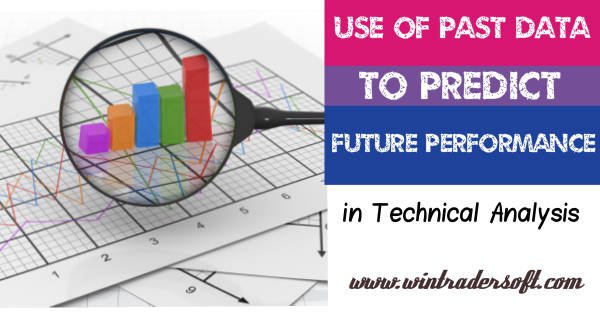Use of Past Data to predict the Future Performance in Technical Analysis

Can the Past Data Be Used to Predict the Future in Technical Analysis?
Another question often raised concerns the validity of using past price data to predict the future. It is surprising how often critics of the technical approach bring up this point because every known method of forecasting, from weather predicting to fundamental analysis, is based completely on the study of past data. What other kind of data is there to work with?
The field of statistics makes a distinction between descriptive statistics and inductive statistics. Descriptive statistics refers to the graphical presentation of data, such as the price data on a standard bar chart. Inductive statistics refers to generalizations, predictions, or extrapolations that are inferred from that data. Therefore, the price chart itself comes under the heading of the descriptive, while the analysis technicians perform on that price data falls into the realm of the inductive.
As one statistical text puts it, “The first step in forecasting the business or economic future consists, thus, of gathering observations from the past. Chart analysis is just another form of time series analysis, based on a study of the past performance and data, which is exactly what, is done in all forms of time series analysis. The only type of data anyone has to go on is past data. We can only estimate the future by projecting past experiences into that future.
So it seems that the use of past price data to predict the future in technical analysis is grounded in sound statistical concepts. If anyone were to seriously question this aspect of technical forecasting, he or she would have to also question the validity of every other form of forecasting based on historical data, which includes all economic and fundamental analysis.
Basic Concepts of Trend
The concept of trend is absolutely essential to the technical approach to market analysis. All of the tools used in technical analysis software support and resistance levels, price patterns, moving averages, trend lines, etc. have the sole purpose of helping to measure the trend of the market for the purpose of participating in that trend. We often hear such familiar expressions as “always trade in the direction of the trend,” “never buck the trend,” or “the trend is your friend.” So let’s spend a little time to define what a trend is and classify it into a few categories.
In a general sense, the trend is simply the direction of the market, which way it’s moving. But we need a more precise definition with which to work. First of all, markets don’t generally move in a straight line in any direction. Market moves are characterized by a series of zigzags. These zigzags resemble a series of successive waves with fairly obvious peaks and troughs. It is the direction of those peaks and troughs that constitutes market trend. Whether those peaks and troughs are moving up, down, or sideways tell us the trend of the market. An uptrend would be defined as a series of successively higher peaks and troughs; a downtrend is just the opposite, a series of declining peaks and troughs; horizontal peaks and troughs would identify a sideways price trend.
You can see the live performance of WinTrader BUY SELL Signal Software. CLICK HERE to register your details for FREE DEMO
Or Contact our representative in below numbers;
- +91 98466 99177 (English)
- +91 90619 73737 (Hindi)
- +91 90613 80308 (Hindi)
- +91 90613 08080 (Tamil, English)
- +91 92492 73612 (Malayalam)
You can find more information from our blog by click the below links;
- Planning to succeed as a Day Trader in MCX, NSE, FOREX with accurate buy sell signal software
- Graphs & Their Application To Speculation In Trading FOREX, MCX, NSE
- The Basic of Identifies Trend Using Moving Average
- Technical Analysis Versus Fundamental Analysis In Trading In Mcx, Nse, Forex Markets
- Winners and Losers in Trading Commodity/Share/Currency Markets a Comparison
- WHAT MAKES A SUCCESSFUL TRADER IN FOREX, MCX, NSE?
- TRADERS NEED TO ASK MORE QUESTIONS FOR TRADING IN COMMODITY/SHARE/STOCK MARKETS
- Start Trading in Commodity/Currency/Share Market As a Business with best buy sell signal software
- Brokerage Free Trading in MCX, NSE, BSE segments with FREE Trading Software
- Tips to follow in trading with best technical analysis software
- The Best Technical Analysis Software WinTrader V7.1 Beta Version Released for MCX, NSE, FOREX
- Benefits of WinTrader Buy Sell Signal Software Over TIPS Providers in India
- The Four Psychological State of Emotions to be controlled by Trader in FOREX, MCX, NSE Trading
- The best buy sell signals from WinTrader Trading System V7.0 for MCX, NSE, FOREX
- Why you should become part of financial market as a part time Intra-Day trader in MCX, NSE or FOREX?
- Intra Day Trading Software: WinTrader Buy Sell Signal System in FOREX, MCX, NSE, COMEX
- Become a Professional Trader With WinTrader The Best BUY SELL Signal Software
- Start making serious money in part time by trading in FOREX, MCX, NSE with WinTrader automatic buy sell signal software?
- WinTrader BUY SELL Signal software performance in MCX & NSE
- Why do traders are doing same mistake again in Trading?
- BUY SELL Signal software Your Way to Profit in Trading
- Stress Free Trading With WinTrader BUY SELL Signal sofware in MCX, NSE, FOREX


